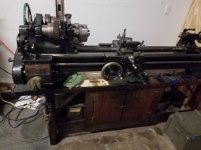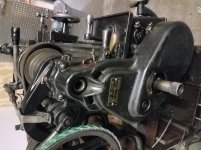Greetings
A South Bend model 584-SB, S/N 37963N, was recently donated to a hackerspace where I am a member. I've not been able to find the 584 explicitly mentioned in a catalog yet, but what catalogs I've been able to find, the setup seems somewhat of a hybrid between the setup of of the 1928 522 9" Simplex Motor Driven Lathe[1, page 6] (the counter-shaft mounting arms in that picture look very much like the ones on our unit), and the 1934 model 784 11" Horizontal V-belt Motor Driven Lathe[2, page 20] (the counter-shaft on ours has that large v-belt pulley). There is one smaller flat-belt pulley on the opposite end of the counter-shaft from the v-belt pulley, such that I thought it was originally designed to be driven from overhead belts, or at least, with that as an option. Or maybe not. It is possible our drive setup is not original -- the mounting of the 1/3HP motor and counter-shafts to the bench looks like a retrofit job effected somewhere during the 1960s or 1970s.
According to the the research the previous owner did, the lathe was originally delivered to a blacksmith shop in Schenectady, NY in 1927. When the original owner died, the lathe was sold to the previous owner's grandfather, whereafter it was passed down to eldest son until it reached the previous owner, who has graciously donated it to the hackerspace along with a bunch of accessories and tooling.
In my searching for information on the 11" lathes, not much is coming up, and most of my Google searches end up directed here. I get the impression that the 11" series where less popular in comparison to the other sizes. What information is linked in the sticky posts at the top of this section has been helpful -- many thanks to the people who have taken the time to preserve and collate that info.
So, what lies in store for our 11" x 5.5'? Well, had I my druthers, it would get a complete teardown, cleaning and rebuild, and paint job. But, I'll have to get buy-in from the other members on that, especially since our other late, a hobbyist-grade combo machine , is also presently out of commission for a cleaning & rebuild. Having both lathes inoperable at the same time will be a hard sell. Hopefully, once the smaller combo lathe/mill/drill press is running again, I can convince the others that taking the time for a full teardown and rebuild is worth it.
There's some talk about replacing the 1/3 single phase motor with one of the 2-3HP DC motors we have in our spare-parts stash. I am also working on plans for a more sturdy mounting for the motor drive. The looseness of the mounting, held in place largely by the weight of the motor and counter-shaft balancing against the tension of a decades-old leather belt, appears to be the main source of vibrations during operation.
What I am hoping to learn is what parts or accessories from the other, more popular lathe series, like the 9", 10" and 13" or others might be compatible with our 11". Or, if nothing is directly compatible, what is close enough that it could be coerced into compatibility with some machine work done on, oh, I don't know, say, a working 11" lathe.
Pictures will be forthcoming.
1. http://www.wswells.com/data/catalog/23/23.pdf
2. http://www.wswells.com/data/catalog/1934_cat_94/1934_cat_94.pdf
A South Bend model 584-SB, S/N 37963N, was recently donated to a hackerspace where I am a member. I've not been able to find the 584 explicitly mentioned in a catalog yet, but what catalogs I've been able to find, the setup seems somewhat of a hybrid between the setup of of the 1928 522 9" Simplex Motor Driven Lathe[1, page 6] (the counter-shaft mounting arms in that picture look very much like the ones on our unit), and the 1934 model 784 11" Horizontal V-belt Motor Driven Lathe[2, page 20] (the counter-shaft on ours has that large v-belt pulley). There is one smaller flat-belt pulley on the opposite end of the counter-shaft from the v-belt pulley, such that I thought it was originally designed to be driven from overhead belts, or at least, with that as an option. Or maybe not. It is possible our drive setup is not original -- the mounting of the 1/3HP motor and counter-shafts to the bench looks like a retrofit job effected somewhere during the 1960s or 1970s.
According to the the research the previous owner did, the lathe was originally delivered to a blacksmith shop in Schenectady, NY in 1927. When the original owner died, the lathe was sold to the previous owner's grandfather, whereafter it was passed down to eldest son until it reached the previous owner, who has graciously donated it to the hackerspace along with a bunch of accessories and tooling.
In my searching for information on the 11" lathes, not much is coming up, and most of my Google searches end up directed here. I get the impression that the 11" series where less popular in comparison to the other sizes. What information is linked in the sticky posts at the top of this section has been helpful -- many thanks to the people who have taken the time to preserve and collate that info.
So, what lies in store for our 11" x 5.5'? Well, had I my druthers, it would get a complete teardown, cleaning and rebuild, and paint job. But, I'll have to get buy-in from the other members on that, especially since our other late, a hobbyist-grade combo machine , is also presently out of commission for a cleaning & rebuild. Having both lathes inoperable at the same time will be a hard sell. Hopefully, once the smaller combo lathe/mill/drill press is running again, I can convince the others that taking the time for a full teardown and rebuild is worth it.
There's some talk about replacing the 1/3 single phase motor with one of the 2-3HP DC motors we have in our spare-parts stash. I am also working on plans for a more sturdy mounting for the motor drive. The looseness of the mounting, held in place largely by the weight of the motor and counter-shaft balancing against the tension of a decades-old leather belt, appears to be the main source of vibrations during operation.
What I am hoping to learn is what parts or accessories from the other, more popular lathe series, like the 9", 10" and 13" or others might be compatible with our 11". Or, if nothing is directly compatible, what is close enough that it could be coerced into compatibility with some machine work done on, oh, I don't know, say, a working 11" lathe.

Pictures will be forthcoming.
1. http://www.wswells.com/data/catalog/23/23.pdf
2. http://www.wswells.com/data/catalog/1934_cat_94/1934_cat_94.pdf












